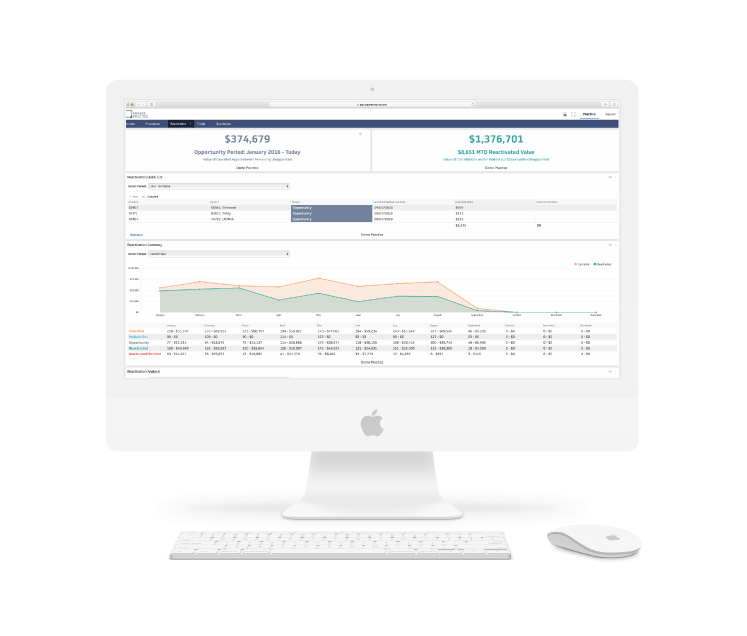
Key performance indicators (KPI's) are valuable tools for you to understand the overall health of your dental practice. As a dental practice owner, you might get bogged down when tasks are added to each patient visit and it can be difficult to choose which KPI's best display an honest picture of your progress. KPI's are all about knowing your numbers as a practice, understanding where you've been to know where you are going and help you know where you'll be tomorrow.
I sat down with a Dental KPI expert and co-founder of Square Practice, Andy Matthews. Square Practice is a cloud-based platform that provides developing intelligence for dental practices and business solutions for individually-owned dental practices, partnerships, groups, and multi-location corporations.
Check out Andy's expertise to learn how you can increase the bottom-line of your dental practice:

Beyond treating scheduled patients, dental practices are filled with activity throughout the day. Managing and keeping an updated schedule is a full-time job. This is on top of trying to create an environment that is welcoming, pleasant, and values a patient's time by running on time.
Practice management systems are an essential piece of technology that keeps the practice running. Management systems do a great job accomplishing the fundamentals of managing a business. However, practice owners and office managers are moving beyond fundamental and towards automation technology. This technology streamlines efficiencies relating to the operational side of running a dental practice...boosting your productivity!
Automation helps remove the manual process of completing routine tasks. This frees up owner/staff time to focus on more important items, such as: patient experience, past due balances owed, and pending treatment that needs to be scheduled.
The #1 asset in a dental practice is the patient base! The active patients KPI is a great starting point for understanding your re-appointment effectiveness. It’s crucial to know how many active patients you have vs. how many unappointed active patients you have.
Practices need to maintain a very high pre-appointment and re-appointment rate to accomplish a measurable rate of growth. Increasing the number of new patients to your practice is one important factor in this formula, but not the whole story. Pre-appointment means after an appointment is completed, the patient schedules their next appointment on the same day; in effect you’ve retained that patient. Re-appointment is scheduling the aftermath of all that don’t schedule their next appointment or patients that end up canceling their only appointment. Measuring both your pre-appointment and reappointment rates are critical indicators in maintaining a growing patient base.
At Square Practice one of our key principles is: “know where you’ve been to know where you’re going”. This, essentially, is having a historical reference to help set realistic and measurable goals.
To properly implement KPIs into your dental practice, you need to understand what you’re measuring and why. Ensure your team is properly inputting information into the management system for clear performance numbers. KPIs are meant to inform you of how your practice is doing. Specifically, where it’s doing well and where there is room for improvement. Meet with your team to review your practice’s performance. Then, create and implement a strategy.
New Patients:
It’s common for practices to measure this number on a printed report from their management system. Generally, it counts a new patient from their first completed appointment. The management system tells part of the story, but not all of the story.
A more telling story would be to understand your total new patients who pre-appointed or reappointed. A new patient who completes their first appointment is just a completed appointment but a new patient who schedules again is a patient that wants to establish a relationship with the practice and is truly a new patient.
Pre-appointment:
This is a fundamental task within a practice. Pre-appointing is making sure a patient leaves with a future appointment. It’s often not measured or tracked. If it is measured, it's usually labeled as reappointment and measured inaccurately.
Treatment Acceptance:
Tracking treatment diagnosed, accepted, and scheduled can be complex. When doctors talk to patients, most times the patient does accept it (Ex. smaller urgent things like a cracked tooth). However, a true treatment plan is a full workup beyond the urgent and immediate. It is a long term plan for the patient.
Many practices base treatment acceptance numbers off of their experience. This doesn’t always tell the whole story. Often, a doctor recommends treatment plans in an urgent or emergency situation with the common denominator being that the patient is in pain. Of course, you will accept a treatment plan that will relieve the pain you are in! That’s why increasing a practice’s bottom-line can’t be based on experience or urgent scenarios. Rather, it needs to be based on specific data and treatment. This is the core of what makes a practice profitable or not!
Same-Day Production:
Perfect scheduling is impossible. However, when it’s so good that it feels like it...then that’s a beautiful thing. We all know what cancellations/no-show appointments can do to a day’s scheduled production numbers. Many practices who measure this KPI want same-day production to be 5-10% of their overall production number. Therefore, practices who implement a strategy in completing procedures that are either 1) diagnosed the day of, or 2) procedures that are pending to be completed that weren’t originally scheduled when the day began, typically achieve their daily production goals!
When considering using a tracking system, whether it’s in business, medicine or another field, you must recognize your purpose of tracking those metrics. It’s important to remember that KPI tracking process is a marathon, not a sprint. From personal experience with tracking marketing metrics in a collaborative setting, it can take several months to demonstrate the value of tracking certain metrics, but once a plan has been implemented and executed, the value of tracking is proven in the results.
There are countless metrics dental practices can track. Now that you have an understanding of dental practice KPI's, you can
start working with your staff to determine the best tracking process for important patient and dental practice data.
CRN202107-251447
Physician Entrepreneurs & Side Gig Explorers Series

Molly was the marketing director at SDT from October 2017 through November 2020. She is passionate about connecting with people, digital marketing, and serving her community.
One of the biggest financial decisions physicians and dentists make involves buying, building, or renovating a house. If you've gone through this ...
Read More →Dental service organizations (DSOs) have gained popularity by enhancing practice efficiency and profitability through their expertise, resources, and ...
Read More →Employing your children in your dental practice can be a decision laden with both potential benefits and challenges. Let's delve into the nuanced ...
Read More →